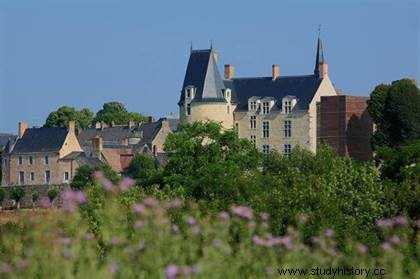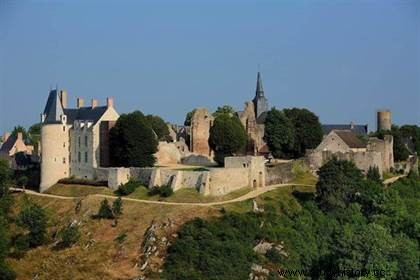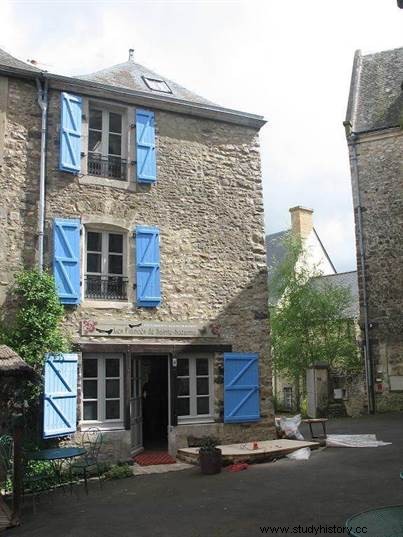 Behind its ramparts and its keep which successfully challenged William the Conqueror, hides one of the Most Beautiful Villages in France , the small medieval town of Sainte-Suzanne . From the top of its rocky outcrop overlooking the Erve valley and located in the heart of the country of art and history from Coëvrons-Mayenne, it is a village rich in history but also in charm and character. An ideal historical discovery destination for the family, it can also be for lovers under the benevolent gaze of Saint Suzanne, patron saint of engaged couples.
Behind its ramparts and its keep which successfully challenged William the Conqueror, hides one of the Most Beautiful Villages in France , the small medieval town of Sainte-Suzanne . From the top of its rocky outcrop overlooking the Erve valley and located in the heart of the country of art and history from Coëvrons-Mayenne, it is a village rich in history but also in charm and character. An ideal historical discovery destination for the family, it can also be for lovers under the benevolent gaze of Saint Suzanne, patron saint of engaged couples.
Origins in the Middle Ages:the story of a fortified village
Former XI stronghold e century, the remains of Sainte-Suzanne date back well beyond the feudal era. Many Celtic remains attest to the antiquity of human settlement. If on the one hand, the oldest monument in the department dating from the 4th th millennium BC, the Dolmen des Erves, rests only a few kilometers from the village, it is above all recent archaeological excavations which made it possible to certify the origins of the city around the V e -VI e centuries before Christ. These excavations revealed in particular the presence of vitrified stones at the foot of the ramparts of the city that the visitor can discover while walking along the fortifications. This is an ancient technique for solidifying walls that we can find as the basis of ramparts mainly in Scotland and Hungary. The technique of vitrified stones was then taken up by the Romans and remains today an enigma for researchers unable to reproduce it.
 It is thus from its origins that Sainte-Suzanne presented itself as a fortified village but which did not really take its rise than in feudal times with the construction of a keep in the XI
th
century by the Viscounts of Beaumont who were quickly in the grip of William the Conqueror from 1083. The latter besieged the fortress in vain for nearly four years, paradoxically making the wealth of the besieged. The defenders of Sainte-Suzanne repeatedly took Norman nobles prisoner in order to free them for ransom.
It is thus from its origins that Sainte-Suzanne presented itself as a fortified village but which did not really take its rise than in feudal times with the construction of a keep in the XI
th
century by the Viscounts of Beaumont who were quickly in the grip of William the Conqueror from 1083. The latter besieged the fortress in vain for nearly four years, paradoxically making the wealth of the besieged. The defenders of Sainte-Suzanne repeatedly took Norman nobles prisoner in order to free them for ransom.
When Guillaume died, his heirs gave up pursuing hostilities, making the Château de Sainte-Suzanne the only fortress that had resisted the Conqueror. Thereafter, the city continued to be fortified, becoming the recurring object of clashes between English and French during the Hundred Years War. The ramparts of the wall were as such damaged by the beginnings of artillery. Defended by a companion of Joan of Arc, Ambroise de Loré, the city was taken by the English masters of Normandy in 1425. It was not until 1439 that the French troops recovered the fortified village thanks to this they say – with the complicity of an English soldier, married to a Suzannaise.
Following the Hundred Years War and apart from the period of the religious wars when the city was again besieged, this time by the leaguers, Sainte-Suzanne experienced a long period of peace, diversifying economically over time:agriculture, livestock, crafts, etc. The visitor will be able to trace the history of the city thanks to the associative museum of the audience but also by the visit of the castle become a Center of Interpretation of Architecture and Heritage (CIAP).
The castle of Sainte-Suzanne
 If the ramparts bordering it date from the XIV
e
and XV
th
centuries, the castle itself dates from the 17
th
century. Indeed, on the ruins of the old fortress bought in 1604 from Queen Marguerite of France, Guillaume Fouquet de la Varenne, minister of Henri IV, wanted to transform this old castle into a residential residence. However, with the assassination of the good king in 1610, Fouquet de la Varenne fell into disgrace. He could not carry out his project, the only part then realized being the house, a beautiful body of building between Renaissance style and classical style, characteristic of the architecture of the Grand Siècle. This thus explains to the visitor why today the old and massive keep in ruins of the XI
th
and the beautiful but sober and frail dwelling housing an Architecture and Heritage Interpretation Centre.
If the ramparts bordering it date from the XIV
e
and XV
th
centuries, the castle itself dates from the 17
th
century. Indeed, on the ruins of the old fortress bought in 1604 from Queen Marguerite of France, Guillaume Fouquet de la Varenne, minister of Henri IV, wanted to transform this old castle into a residential residence. However, with the assassination of the good king in 1610, Fouquet de la Varenne fell into disgrace. He could not carry out his project, the only part then realized being the house, a beautiful body of building between Renaissance style and classical style, characteristic of the architecture of the Grand Siècle. This thus explains to the visitor why today the old and massive keep in ruins of the XI
th
and the beautiful but sober and frail dwelling housing an Architecture and Heritage Interpretation Centre.
 Project of the General Council to restore it to present the history and heritage of the department, the castle of Sainte- Suzanne is not a simple museum but a CIAP. In other words, this space relies above all on interactivity with the visitor by providing them with documentation spaces and information databases on the heritage of the Mayenne, by programming events, meetings and debates or by supporting a regular renewal of temporary exhibitions in order to highlight certain aspects of the territory of the department.
Project of the General Council to restore it to present the history and heritage of the department, the castle of Sainte- Suzanne is not a simple museum but a CIAP. In other words, this space relies above all on interactivity with the visitor by providing them with documentation spaces and information databases on the heritage of the Mayenne, by programming events, meetings and debates or by supporting a regular renewal of temporary exhibitions in order to highlight certain aspects of the territory of the department.
Also accessible to the disabled, the CIAP shows its desire to work with all audiences by presenting all the heritage of Mayenne. Because if part of the castle is obviously attached to the history of Sainte-Suzanne, it is indeed 300,000 years of history of a department which are revealed through the architectural, archaeological and other natural heritage, all in a fun and very interactive way.
Sainte-Suzanne:a dive into history
A charming medieval town, Sainte-Suzanne not without reason collects tourist labels. Playing on its patronage of fiancés with, for example, a very good concept of a lovers' cottage housed in a 14 th hovel century, Sainte-Suzanne offers in many aspects a real dive into the history of its department, both global thanks to its castle and above all medieval and modern by the city with its maze of cobbled streets, its ancient monuments such as the attic salt or its walk along the towers and ramparts.
In addition, with its gothic calligraphy and illumination workshop which will fascinate young and old, its demonstrations on weapons from the Middle Ages and the Renaissance or its soap-making craft , etc., Sainte-Suzanne offers its visitors various and very interesting activities helping to extend this journey through time.
To go further
Castle of Sainte Suzanne in Mayenne
